what does a base raised to a negative exponent mean
Many students already struggle to understand negative numbers, exponent rules and fractions. So what happens when you lot add negative exponents to the equation?
Total chaos.
Well, not really. But understanding negative exponents is an important building block for high school-level math courses, and it's as well a concept many students observe challenging. When you lot gradually build on your students' knowledge, you'll ensure they're ready to tackle challenging issues in and out of the classroom.
If you're not certain where to begin, this blog post will help you lot transform your unit on negative exponents into a positive experience for yous and your students!
Negative exponents rules

Similar everything else in math form, negative exponents take to follow rules. If you demand a reminder , here's a quick recap of the seven rules of exponents:
- Product of powers: Add powers together when multiplying like bases
- Quotient of powers dominion: Subtract powers when dividing like bases
- Power of powers rule: Multiply powers together when raising a power by another exponent
- Power of a product rule: Distribute power to each base when raising several variables by a power
- Power of a quotient rule: Distribute power to each base when raising several variables by a power
- Zero power dominion: Any base raised to the power of zip becomes one
- Negative exponent rule: To alter a negative exponent to a positive one, flip it into a reciprocal.
Remind students that the rules stay the aforementioned with negative exponents — there just might be a few extra steps to follow.
A quick review of negative numbers
Negative numbers require a certain amount of abstract thinking that doesn't always come naturally. Merely without a solid understanding of negative numbers, students won't be ready to tackle negative exponents.
Hither's a quick review:
A negative number is any number less than zippo.
Negative numbers are expressed with a negative sign. For instance, -iv is four less than goose egg.
It'south helpful to recollect of negative numbers as existing on a number line:
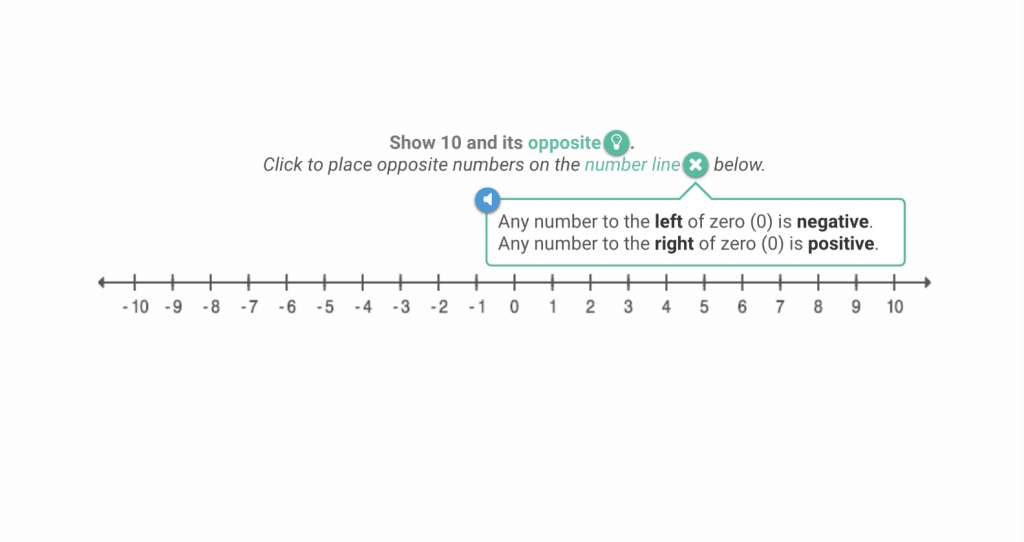
When y'all add and subtract negative numbers, y'all're either moving to the right or the left of the number line.
When you subtract a negative number you move to the left of the number line, because it'southward the same as calculation a positive number. If yous're adding a negative number y'all motion to the right because it's the aforementioned as subtracting a positive number.


When you multiply a negative number by a positive number (or vice versa), the product volition be negative. If you multiply two negative numbers or 2 positive numbers, the result will exist positive.
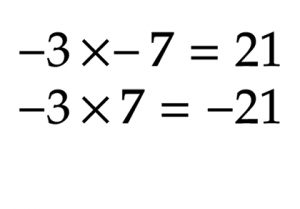
Multiplying different signs will e'er give you lot a negative product, and multiplying the same signs volition give you a positive product. Always assume the number is positive if at that place'due south no sign in front end of it.
What do negative exponents mean?
Nosotros already know that positive exponents are a manner of expressing repeated multiplication. For case:
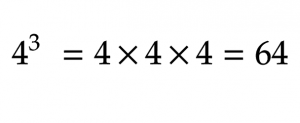
In that location are a few unlike ways of thinking almost negative exponents, but in full general, negative exponents are the opposite of positive ones.
All negative exponents can be expressed as their positive reciprocal. A reciprocal is a fraction where the numerator and denominator switch places.
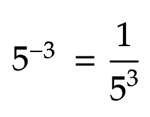
How can something be flipped into a reciprocal if it wasn't a fraction to offset?
Nosotros know that numbers can be expressed in more one way. For case, eight can besides be written as:
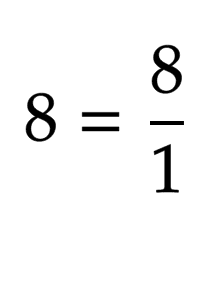
So, negative exponents can exist expressed as the positive reciprocal of the base of operations multiplied by itself 10 times.
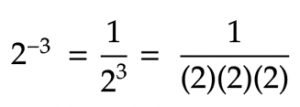
The larger the negative exponent, the smaller the number it represents. While positive exponents signal repeated multiplication, negative exponents represent repeated division. That's why 2-3is greater than 2-half-dozen.
How to solve negative exponents
Most questions will enquire you to solve negative exponents by expressing them as positive equations. Hither'south how:
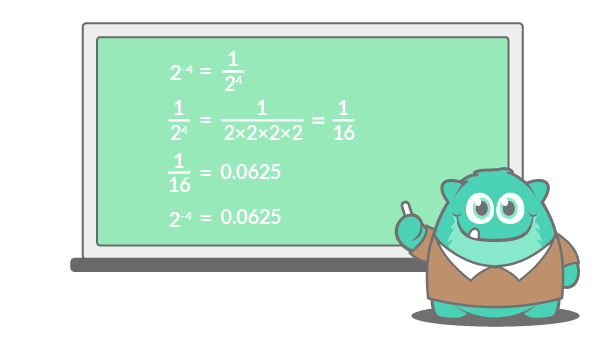
Flip the base and exponent into the reciprocal, then solve the denominator. Divide the numerator by the denominator to find the last decimal.
Multiplying and dividing negative exponents
We've already covered multiplying exponents, only here's a quick review on how to multiply and divide negative exponents.
Multiplying negative exponents
Skilful news! The rules for multiplying exponents are the same, even when the exponent is negative.
If the bases are the same, add together the exponents. Remember to keep in listen the rules for adding and subtracting negative numbers.

If the bases are dissimilar but the exponents are the same, multiply the bases and leave the exponents the way they are.

If there's cypher in common, get straight to solving the equation. Flip the exponents into their reciprocals, then multiply.
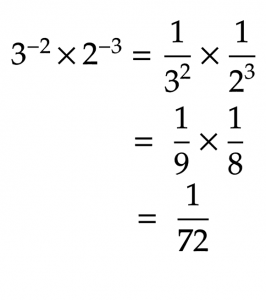
If you lot demand a reminder, bank check out our post on How to Multiply Fractions.
Dividing negative exponents
Dividing negative exponents is near the same as multiplying them, except you lot're doing the contrary: subtracting where y'all would have added and dividing where yous would take multiplied.
If the bases are the aforementioned, decrease the exponents.
Remember to flip the exponent and make information technology positive, if needed.
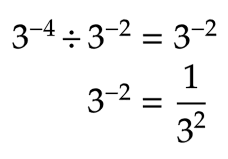
If the exponents are the same but the bases are different, divide the bases first.
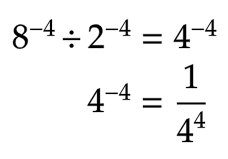
If in that location'southward nothing in common, go directly to solving the equation.
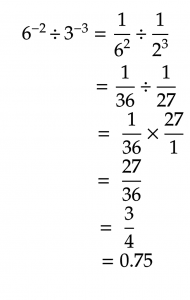
For a refresher on dividing fractions, check out our How to Split up Fractions weblog post.
Negative numbers with exponents

What happens if the base is negative instead of the exponents?
If the exponent is positive, work with it as you would a regular exponent, but recollect two things:
- If the base is negative and the exponent is an even number, the terminal product will always exista positive number.
- If the base is negative and the exponent is an odd number, the final product volition always bea negative number.
If there are parentheses around the negative base, the power applies to the entire equation -- including the negative sign. If there are no parentheses, the ability applies simply to the base and not to the negative sign.
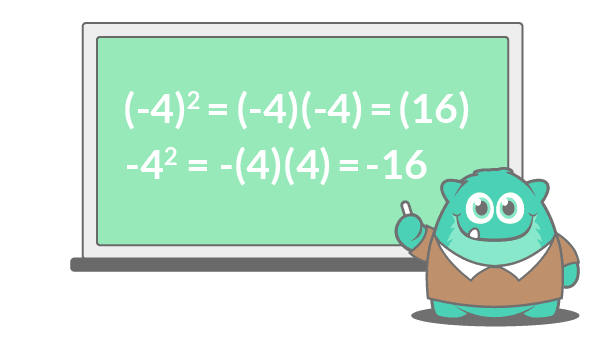
Since the first instance is being raised to an even ability, the two negative signs cancel out and you're left with a positive product. If the exponent was an odd power, the production would be negative considering there would be one number that couldn't cancel out.
In the 2d example, the positive ability simply applies to the four, not to the negative sign. In this case, the negative sign tells you lot the product volition be negative whether the power is odd or even.
Simplifying negative exponents
Multiplying, dividing and understanding negative exponents is the first step to simplifying expressions with negative exponents.
Recall: all the steps covered above hold true no matter how complicated the expression is.
Permit's offset by multiplying negative exponents with variables.
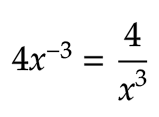
In this example, the power only applies to the x base, not the 4. To brand it a positive expression, flip the x to the reciprocal and keep the 4 on top.
Let's try something a lilliputian more complicated.
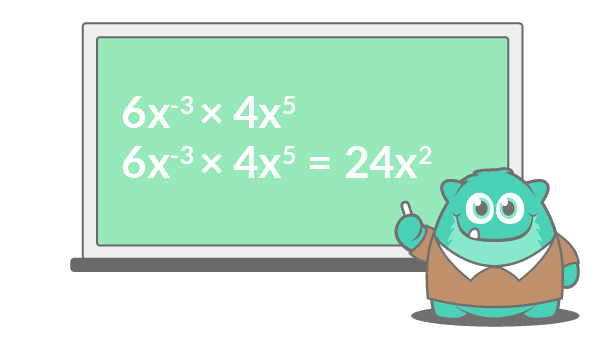
The variables here are the same, so according to the start exponent rule, we tin can multiply the numbers, keep the base the same and add the exponents together.
Multiply the vi and 4 for a product of 24. Then, add the exponents together to multiply the 10 variables.
What about dividing negative exponents with variables?
Permit'south starting time with a unproblematic case:
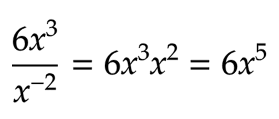
To make the negative exponent positive, move the ???? to the top of the equation and multiply.
Here'south an example of negative exponents with multiple variables:

Since the negative exponent only applies to the variable, move 𝑥-iv to the bottom of the equation to make information technology positive, and get out the 6 where it is.

And there'due south your simplified equation!
Allow'due south try another one.

Outset, redistribute the power to the inside of the brackets, following the tertiary exponent dominion.
Then, flip the 𝑥 variables with negative exponents to their reciprocal.
Finally, multiply the 𝑥 variables by adding the exponents together.
Let'south exercise one more.

To offset, either square the equation or move the parentheses outset. We'll brainstorm by squaring the height subclass and redistributing the power.
So, motility the negative exponents down or up, depending on their positions. A negative exponent on elevation can be brought to the bottom so it'south a reciprocal, and vice versa. Stop by simplifying.
There's often more than one way to simplify negative exponent expressions. Since exponents are repeated multiplication, and you can multiply numbers in whatever society you'd like, different steps can lead to the same upshot.
Fractions with negative exponents
We know what to do with whole numbers that have negative exponents, merely what about fractions with negative exponents?
To simplify fractions with negative exponents, flip them to their reciprocals, multiply and reduce.

How to teach negative exponents with Prodigy
Students will love practicing negative exponents with Prodigy: a free, curriculum-aligned math platform packed with exotic pets, fun challenges and educational take a chance.
Negative exponents are an important concept for students to grasp before they outset high school, just many learners struggle with key concepts. Using powerful reporting tools in yourTeacher Dashboard, you'll see which topics your students take mastered, and where they demand more practice.

Prodigy'sAssignments, Plans and Test Prep features permit y'all assign targeted math practice for students who are struggling or excelling. Yous'll go real-time data as students play, and you'll exist able to deliver differentiated assignments that align with what you're teaching in class. You can apply Prodigy to:
- Deliver spiral assessments
- Prepare for standardized tests
- Reinforce in-class lessons (similar negative exponents!)

Final thoughts on negative exponents
If you'd like more practice on exponents in general, our exponent rules worksheet gives students the opportunity to get more than familiar with how exponents work.
When working with negative exponents, it's of import to think all the exponent rules stay the same. Too this, the merely thing students need to know is how to add together, subtract, multiply and dissever negative numbers.
Take it slow, and build upwards to more complicated questions. Your students will exist exponent whizzes in no time at all!
Start teaching negative exponents with Prodigy today. Prodigy is a no-toll, curriculum-aligned math platform that encourages students to love learning math. With over a million teachers and 50 meg students, Prodigy offers unique solutions for your classroom.

Source: https://www.prodigygame.com/main-en/blog/negative-exponents/
0 Response to "what does a base raised to a negative exponent mean"
Post a Comment